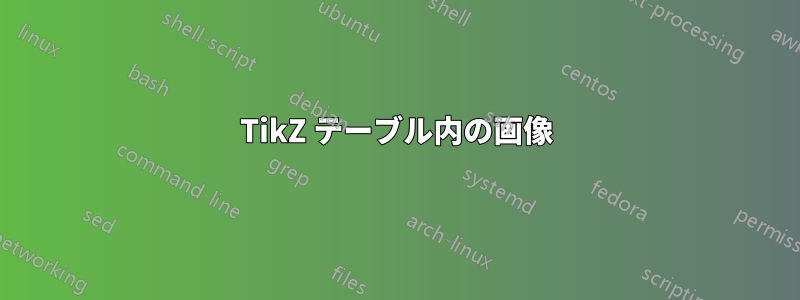
誰かテーブルについて手伝ってくれませんか? TikZ 画像のアウトラインとテーブル ラインの間に距離を置きたいのですが、さらに、TikZ 以外の画像は中央に配置されません。
これが私の LaTeX コードです:
\documentclass[a4paper,10pt]{article}
\usepackage{tikz,amsmath, amssymb,bm,color}
\usetikzlibrary{circuits.logic.US,circuits.logic.IEC}
\begin{document}
\begin{table}
\caption{Test}
\label{de:Wahrheitstabelle_Bsp01}
\setlength{\tabcolsep}{5mm} % separator between columns
\def\arraystretch{1.25} % vertical stretch factor
\centering
\begin{tabular}{|c|c|c|}
\hline
Gatter & Funktion & CNF-Formel \\ \hline
\begin{tikzpicture}
\draw (-1.5,-0.75) rectangle (1.5,0.75) ;
\end{tikzpicture} & 0 & 1 \\ \hline
\begin{tikzpicture}[circuit logic US, logic gate input sep=4mm]
\node [or gate, inputs =nn] (a1) {};
\draw (a1.input 1) -- ++(left:5mm) node[left] {$x_{1}$};
\draw (a1.input 2) -- ++(left:5mm) node[left] {$x_{2}$};
\draw (a1.output)--++(right:5mm) node[right] {$x_{3}$};
\end{tikzpicture} & 0 & 1 \\ \hline
\begin{tikzpicture}[circuit logic US]
\node (a1) [not gate, inputs =n] at (0,0) {};
\draw (a1.input) -- ++(left:5mm) node[left] {$x_{1}$};
\draw (a1.output)--++(right:5mm) node[right] {$x_{2}$};
\end{tikzpicture} & $x_{2} \equiv \neg x_{1}$ & $(x_{2} \vee x_{1}) \wedge (\neg x_{2} \vee \neg x_{1})$ \\ \hline
\end{tabular}
\end{table}
\end{document}
これが私の表です:

答え1
tikzpicture の周囲の垂直余白を修正するには、fitライブラリと特別なノードを使用できますcurrent boundind box。次の例では、\addvmarginマクロはこの方法を使用しています。
tikzpicture の垂直方向の位置合わせを修正するには、baselineオプションを使用できます。ここでは、0最初の tikzpicture のベース ラインとして選択していますが、任意の垂直座標を選択できます。最後の 2 つの tikzpicture では、参照として任意のノードを選択します。

\documentclass[a4paper,10pt]{article}
\usepackage{tikz,amsmath, amssymb,bm,color}
\usetikzlibrary{circuits.logic.US,circuits.logic.IEC,fit}
\newcommand\addvmargin[1]{
\node[fit=(current bounding box),inner ysep=#1,inner xsep=0]{};
}
\begin{document}
\begin{table}
\caption{Test}
\label{de:Wahrheitstabelle_Bsp01}
\setlength{\tabcolsep}{5mm} % separator between columns
\def\arraystretch{1.25} % vertical stretch factor
\centering
\begin{tabular}{|c|c|c|}
\hline
Gatter & Funktion & CNF-Formel
\\ \hline
\begin{tikzpicture}[baseline=0]
\draw (-1.5,-0.75) rectangle (1.5,0.75) ;
\addvmargin{1mm}
\end{tikzpicture} & 0 & 1
\\ \hline
\begin{tikzpicture}[baseline={(x3.base)},circuit logic US,logic gate input sep=4mm]
\node [or gate, inputs =nn] (a1) {};
\draw (a1.input 1) -- ++(left:5mm) node[left] {$x_{1}$};
\draw (a1.input 2) -- ++(left:5mm) node[left] {$x_{2}$};
\draw (a1.output)--++(right:5mm) node[right] (x3) {$x_{3}$};
\addvmargin{1mm}
\end{tikzpicture} & 0 & 1
\\ \hline
\begin{tikzpicture}[baseline={(x1.base)},circuit logic US]
\node (a1) [not gate, inputs =n] at (0,0) {};
\draw (a1.input) -- ++(left:5mm) node[left] (x1) {$x_{1}$};
\draw (a1.output)--++(right:5mm) node[right] {$x_{2}$};
\addvmargin{1mm}
\end{tikzpicture} & $x_{2} \equiv \neg x_{1}$ & $(x_{2} \vee x_{1}) \wedge (\neg x_{2} \vee \neg x_{1})$
\\ \hline
\end{tabular}
\end{table}
\end{document}


